Method for processing an intrusion into a wireless communication network, related device and computer program
- Summary
- Abstract
- Description
- Claims
- Application Information
AI Technical Summary
Benefits of technology
Problems solved by technology
Method used
Image
Examples
first embodiment
[0088]FIG. 3 shows the steps of a method for processing an intrusion according to the invention.
[0089]According to this first embodiment of the invention, it is considered that the nodes of the network RC are organised according to a distributed architecture.
Such a method is advantageously implemented by a current node NC of the communication network RC. An exemplary neighbourhood of the current node NC is illustrated in connection with FIG. 4.
[0090]During a step T1, the current node NC discovers its one-hop neighbourhood V1S(NC) and its two-hop neighbourhood V2S(NS). To this end, in a known manner, each node device, in particular the current node NC, periodically sends a neighbourhood message which contains at least one identifier (NC) of the current node and at least one list of its one-hop neighbouring nodes.
[0091]At initialisation, it is assumed that the current node NC has assigned to each of its neighbours a “normal” or “reliable” status.
[0092]As shown in FIG. 4, a one-hop nei...
second embodiment
[0141]Let us now consider, in connection with FIG. 6 the invention in which the communication network RC is organised hierarchically.
[0142]According to this architecture, the nodes are grouped into clusters, each cluster being supervised by a so-called “cluster head” node TC and enjoying particular prerogatives. In particular, the cluster head node determines the behaviour of the nodes in its cluster.
[0143]FIG. 6 illustrates three clusters Cl1, Cl2, Cl3 for example. We consider the current node NC that belongs to the cluster Cl1 and acts as a cluster head.
[0144]It will become apparent note that a node can belong to one or more clusters. This is particularly the case of the node N9 that belongs to both clusters Cl1 and Cl3 and of the node N4 which belongs to both clusters Cl1 and Cl2.
[0145]In connection with FIG. 7, we shall describe the steps of the method for processing an intrusion implemented by the current node NC according to the second embodiment of the invention.
[0146]In this...
PUM
 Login to View More
Login to View More Abstract
Description
Claims
Application Information
 Login to View More
Login to View More - R&D
- Intellectual Property
- Life Sciences
- Materials
- Tech Scout
- Unparalleled Data Quality
- Higher Quality Content
- 60% Fewer Hallucinations
Browse by: Latest US Patents, China's latest patents, Technical Efficacy Thesaurus, Application Domain, Technology Topic, Popular Technical Reports.
© 2025 PatSnap. All rights reserved.Legal|Privacy policy|Modern Slavery Act Transparency Statement|Sitemap|About US| Contact US: help@patsnap.com



